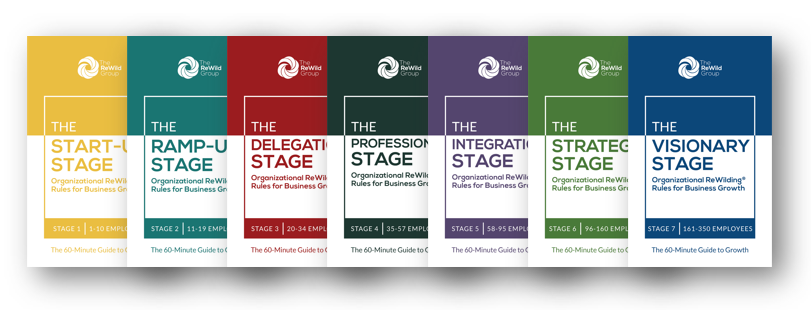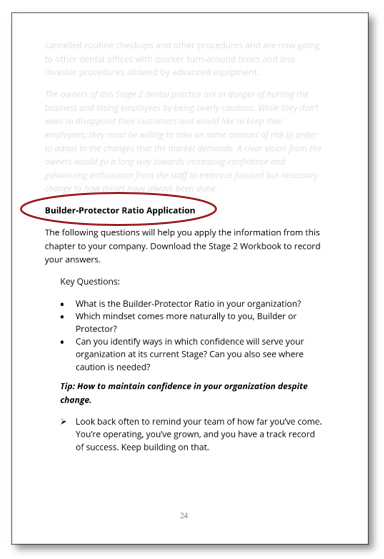
THE STAGES OF GROWTH GUIDEBOOKS
60-Minute Guidebooks for Business Growth
Work Matters. Make it Exceptional.
Whether you are starting out as a solopreneur or leading a company of 300+ employees, there are rules for growth that will help you navigate your way through your current challenges and on to the next stage. These rules aren’t arbitrary, either—they’re based on over 30 years of research and observation of more than 1,500 small and midsize businesses across dozens of industries. Learn from the collective experience of other business owners and leverage that knowledge to propel your business forward.
Each book in the series is practical and succinct, created to be read in 60 minutes and filled with useful tips and questions to help you apply the concepts directly to your business. The Stages of Growth are based on the number of employees at your company, so select the one that’s applicable to you and discover the rules that will help you succeed.
Take a look inside!
1. Dimension Overview
Each chapter begins with an overview of one of the dimensions of a healthy business. The Builder-Protector Ratio is one of those dimensions. There are eight in all.
2. Stage-Specific Application
After the overview, you’ll find an explanation of how that dimension specifically applies to that Stage. In Stage 3, for example, the chapter details the ideal Builder-Protector Ratio for a Stage 3 business.
3. Illustration
Nearly every dimension represents an ideal for businesses to follow. For that reason, the next section illustrates what happens when a business is out of alignment with the ideal.
4. Questions & Tips
To help you put the information to use immediately, there is also an application section at the end of each chapter. You’ll find three or four questions to help you reflect on the material and apply it to your business, as well as a tip that you can carry with you.
“Stages of Growth makes sense of the common challenges of starting and growing a business. You will grow your thinking and ability to communicate as a business owner or a leader if you invest in learning the secrets that The ReWild Group is presenting in a very straightforward and actionable format. ”
Organizational ReWilding® Rules for Business Growth
All seven of the Organizational ReWilding® Rules for Business Growth books are available for purchase on Amazon! Choose from Kindle or paperback format.
Stage 1: The Start-Up Stage
1-10 Employees
A Stage 1 business is in a unique phase. With only 1-10 employees, each person is critical to the success of the enterprise. Profit is the first priority, and the organization must be confident overall, with a leader who casts and executes on a strong vision, coaches employees to develop their potential, and pushes through chaos with decisive decision making.
Stage 2: The Ramp-Up Stage
11-19 Employees
As the Ramp-Up Stage, a Stage 2 company is at a place where it has gained enough employees that more organizational structure needs to be put into place. The owner or CEO needs to focus on developing up to three supervisors/managers who can begin to help oversee some of the team. Growth must continue to come through the increase of profitable revenue, which typically requires increasing the structure and consistency of business development initiatives. Failure to create stable revenue streams will lead to the company stalling, or potentially retreating from its current position.
Stage 3: The Delegation Stage
20-34 Employees
As the Delegation Stage, A Stage 3 company is in the process of shifting from being owner-centric to enterprise-centric. As such, this Stage is often one of the most difficult for the CEO. People are a top priority, with an early form of a management team being developed to prepare for further growth. The organization must be equal parts cautious and confident, with a leader who coaches the employees and promotes staff buy-in while still exemplifying a standard of excellence.
“Explore this short read packed with the realities of business complexities and proven solutions. Embrace the practical resources presented and your leadership brand will change forever. Your team and those that matter most to your life will thank you!”
Stage 4: The Professional Stage
35-57 Employees
With an early-stage management team that needs to be professionalized, that’s the name of this Stage – Professional. Whether an organization trains existing managers to the next level or hires outside professionals, this is a building block that cannot be missed for successful growth into further Stages. One of the most important things the professional management team does in Stage 4 is to work on the processes and systems of the organization. Leveraging their functional expertise, managers build the infrastructure that supports future growth.
Stage 5: The Integration Stage
58-95 Employees
Stage 5 marks a time of integration for a company as the different departments are brought together by an integrated management team. Profit is a top priority to ensure that enough capital is generated to sustain a larger organization. The organization should exhibit twice as much confidence as caution in support of the focused change needed to install a Leadership Team and continue to pursue new opportunities. The leader needs to primarily guide through collaboration, inspire the team with a grand vision, and build loyalty through comradery.
Stage 6: The Strategic Stage
96-160 Employees
Stage 6 marks a time when the company must shift to long-term, strategic planning in order to stay competitive in the marketplace. The considerable growth in the number of employees has many implications for the structure and priorities of the business, affecting everything from leadership style to operations to workplace community.
Stage 7: The Visionary Stage
161-350 Employees
While enjoying relative stability, a primary concern for leadership is to ward off stagnation. Stage 7 is known as the Visionary Stage because the leader must devote a significant amount of time and energy to creating and communicating a vision that unites and directs the entire company.
Calculate the Stage of Your Business
Not sure which guidebook to buy? No problem! Just fill in the answers below to find out which book is right for you.
The Element Guidebook Series
Good news! There are more insights to discover in the Elements of An Exceptional Business series. Each book corresponds with one of the 11 elements and explains the underlying principles of the element. Application questions and illustrative examples help make the concepts tangible and easier to apply to your business.
Testimonials
Find out what other business owners and advisers are saying about The ReWild Group.
Visit our Testimonials page to hear first-hand accounts of what other business owners and advisers have experienced with Organizational ReWilding®. You’ll find short videos, quotes, and case studies that illustrate the power of the methodology. Check back often for updates! The stories are growing rapidly. (Who knows? Yours might be next …)













